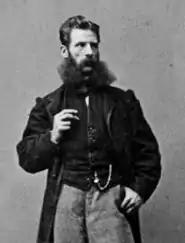
Teutwart Schmitson (18 April 1830, Frankfurt am Main - 2 September 1863, Vienna) was a German-Austrian genre and animal painter, in the Realistic style. He specialized in horses and cattle.
Life and work

His father, also named Teutwart Schmitson (1784-1856), was an Oberstleutnant, military writer, and representative of Austria to the German Confederation. His mother was the sister of Protestant theologian, Johann Heinrich Bernhard Dräseke. He was their only son. Until the age of twenty-two, he studied architecture, then he began drawing and painting in oils as a hobby; developing a technique for lowering the oil content of the paint by applying it to plasterboard for a few hours before putting it on the palette. There is no record of his having had formal instruction.
His first public exhibition was in 1854, at the Städelsches Kunstinstitut in Frankfurt, where he displayed a scene of a farmer, plowing.[1] That same year, against his father's wishes, he married Wilhelmine Beckel (1829–1908), from Wiesbaden, and they went to live in Düsseldorf, which was a major center for art at that time. Their daughter, Therese, was born there the following year. The marriage would end in divorce.
In Dusseldorf, he opened a studio and took some students; notably Carl Rudolf Huber. From 1855, he was a member of the progressive artists' association, Malkasten.[2] He also formed a small group with his fellow animal painters, Eugen Krüger and Adolf Schreyer.[3] In 1856, he moved to Karlsruhe, but was there for only a year when he relocated to Berlin.
There, he came under the influence of the animal painters, Otto Weber and Paul Friedrich Meyerheim. In return, Meyerheim was impressed by his methods for representing movement. The critics were not equally impressed, however. and his success was limited. From 1860 to 1861, he took an extended study trip to Italy.
After brief stays in Paris and The Hague, he settled in Vienna, where he lived in seclusion and worked on commissions, many of which were arranged by his friends. He gradually went blind, due to nephritis, which proved to be fatal. An auction of his sizeable estate was held three months after his death.
References

- ↑ Teutwart Schmitson. In: Männer der Zeit. Biographisches Lexikon der Gegenwart. Zweite Serie, Verlag von Carl B. Lorck, Leipzig 1862, Sp. 310 (Google Books)
- ↑ Bettina Baumgärtel, Sabine Schroyen, Lydia Immerheiser, Sabine Teichgröb: Verzeichnis der ausländischen Künstler und Künstlerinnen. Nationalität, Aufenthalt und Studium in Düsseldorf. In: Bettina Baumgärtel (Hrsg.): Die Düsseldorfer Malerschule und ihre internationale Ausstrahlung 1819–1918. Michael Imhof Verlag, Petersberg 2011, ISBN 978-3-86568-702-9, Band 1, S. 439
- ↑ Richard Graul: Adolph Schreyer. In: Zeitschrift für bildende Kunst, 23 (1888), pp.153–159; Online @ Kronberger Maler
Further reading
- Constantin von Wurzbach: "Schmitson, Teutwart." In: Biographisches Lexikon des Kaiserthums Oesterreich (Biographical Lexicon of the Empire of Austria). Part 30 Kaiserlich-königliche Hof- und Staatsdruckerei, Vienna 1875, p. 327 (digitalised).
- Paul Friedrich Meyerheim: "Meine Erinnerungen an Teutwart Schmitson". In: Kunst und Künstler. Illustrierte Monatsschrift für Bildende Kunst und Kunstgewerbe 2, 1904, pp. 343–351 (Online)
- Eduard Daelen (1908), "Schmitson, Teutwart", Allgemeine Deutsche Biographie (in German), vol. 54, Leipzig: Duncker & Humblot, p. 124
- G. Frodl: "Schmitson, Teutwart". In: Österreichisches Biographisches Lexikon 1815–1950 (ÖBL). Vol. 10, Austrian Academy of Sciences, Vienna 1994, ISBN 3-7001-2186-5, p. 334.
External links
![]() Media related to Teutwart Schmitson at Wikimedia Commons
Media related to Teutwart Schmitson at Wikimedia Commons